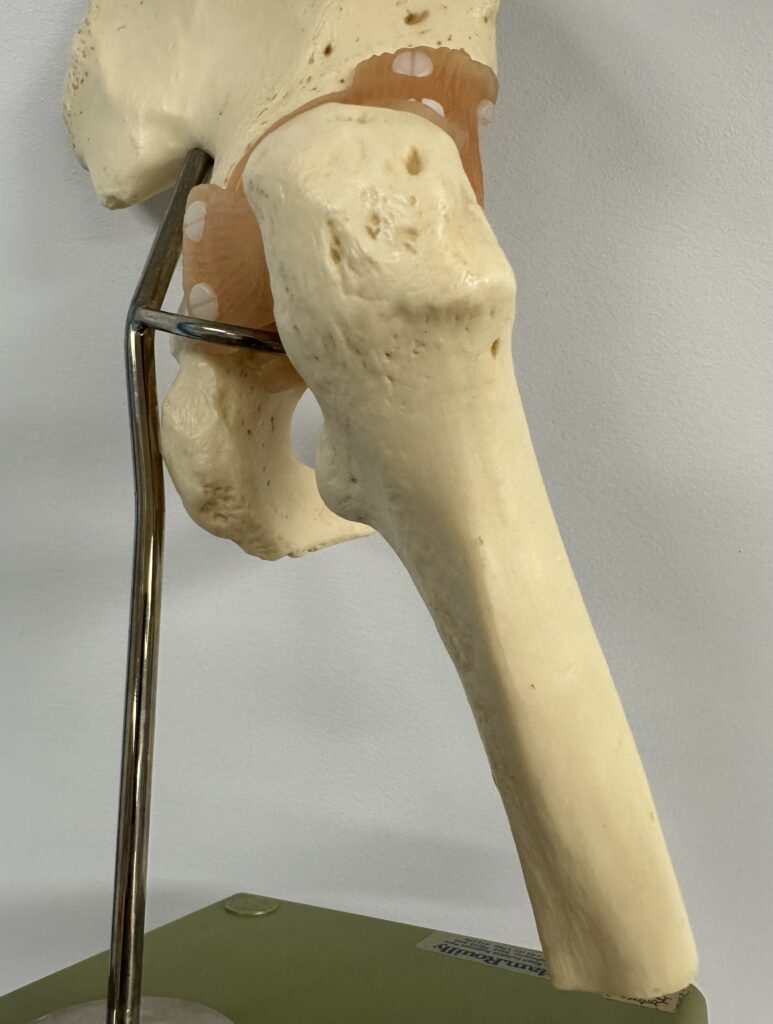Are you experiencing hip pain and looking for answers? Greater Trochanteric Pain Syndrome (GTPS) might be the cause.
This quick guide will help you understand what Greater Trochanteric Pain Syndrome is, why it hurts and what you can do to manage the pain and get your mobility back.
Lets get into the details on symptoms, diagnosis and treatment, all here to get you pain free.
Key Points
Greater Trochanteric Pain Syndrome (GTPS) is a chronic condition of the hip muscles and tendons that can get in the way of daily activities and quality of life due to pain in the bursa, muscles and tendons around the hip joint.
The underlying cause of Greater Trochanteric Pain Syndrome is repeated stress on the hip’s structures such as the gluteal tendons and the trochanteric bursae which is often worsened by repetitive motion, certain postures and underlying medical conditions.
Management of Greater Trochanteric Pain Syndrome uses a multi disciplinary approach, starting with conservative treatments like physical therapy and NSAIDs and progressing to more invasive options like Cortisone injections, PRP, Prolotherapy and occasionally surgery.
What is Greater Trochanteric Pain Syndrome
In Greater Trochanteric Pain Syndrome (GTPS) you experience hip pain (generally on the outside of the hip) that can also affect your thigh or buttock. It’s often a chronic pain that comes and goes and gets in the way of your daily activities.
At the centre of this syndrome is a problem with the muscles and tendons around your hip, specifically the gluteus medius and gluteus minimus tendons.
These muscles and tendons stabilise your hip and allow you to walk, run and move with ease. When they suffer from tendinopathy or tears, it leads to greater trochanter pain and limits your movement and quality of life.
What actually causes this? The friction between the iliotibial band and the greater trochanter, repetitive motion and microtrauma to the gluteal tendons all contribute to this condition.
Understanding these mechanisms is key to getting pain relief and developing a management plan.
Anatomy of Discomfort: The Hip’s Weak Spots
The hip joint is designed for motion, stability and weight bearing.
The Greater Trochanter, a bony prominence on the outside of the thigh bone is the most common area of pain because it is where several critical structures come together; the gluteal tendons and the trochanteric bursae.
These are the cushioning and connecting parts of the hip’s machinery and when they get irritated the result is hip pain.
Anatomy: the Gluteal muscles – Gluteus Medius and Minimus – attach to this very greater trochanter.
When these muscles are weak the result is not just pain but altered hip biomechanics that affects your whole body including the affected leg.
Activities like prolonged sitting especially with crossed legs or standing on one leg can exacerbate the issue as it puts additional stress on the hip’s weak spots.
Lying in bed on the affected side can cause pain to the point you have to alter sleeping position frequently.
Also at risk is the the iliotibial band (ITB), a thick band of tissue that runs along the outside of the thigh, which can compress these soft tissue structures against the greater trochanter especially during activities such as walking or running.
This ‘compression‘ can irritate the gluteal tendons and bursae and lead to inflammation and pain, the classic symptoms of GTPS.
Understanding these anatomical details is key to finding the source of the discomfort and developing the right management plan.
What causes Greater Trochanteric Pain Syndrome
GTPS can come from multiple factors that often overlap. Repetitive movements whether from sports or occupational activities along with sudden increases in activity levels are key factors in the development of this syndrome.
Prolonged sitting especially in chairs that offer little support or consistently standing on one leg can contribute to the development of GTPS.
These may seem like simple activities but over time they can create an environment for chronic pain to develop.
Add to this individual variations in pelvis morphology, obesity and an inactive lifestyle and you have a recipe for problems in this region. Knowing these risk factors can help in preventing and managing GTPS better.
And other medical conditions can be a factor. Osteoarthritis of the hip or knee and lower back pain are associated with a higher risk of GTPS.
It’s a domino effect where one condition can trigger another, so it’s important to look at the whole picture when diagnosing and treating GTPS.
Knowing these root causes sets the stage for a more targeted approach to pain relief and preventing chronic pain.
GTPS Pain Symptoms
GTPS symptoms can vary between individuals but there are common themes that run through them.
The most common symptom is pain on the outside of the hip, thigh or buttock area with the pain sometimes radiating down the leg.
This pain can be exacerbated by simple activities such as side bending or sitting for long periods. Even sleeping on the painful side can become difficult.
In a clinical setting GTPS presents a clear picture. Pain on the outside of the hip and tenderness on pressing this area, as well as pain during hip rotation or resistance to hip abduction.
These clinical findings when present have a very high suspicion for GTPS.
Knowing the main symptoms is key to diagnosis and pain management. Some common symptoms of GTPS are:
Pain on the outside of the hip
Pain that radiates down the leg
Pain that gets worse with activity
Pain that’s worse at night
Pain that’s worse with sitting or lying on the affected side
By knowing these pain patterns and triggers you can seek advice and interventions that addresses your specific pain profile.
GTPS Diagnosis
Diagnosing GTPS involves:
Medical history: Your pain history is explored.
Clinical tests: Hands on assessment of your symptoms.
Diagnostic imaging: Scans of the hip muscles.
Radiographic imaging and MRI come into play not just to diagnose GTPS but to rule out other problems such as Hip Osteoarthritis or Gluteus Medius/Minimus tendinopathy.
It is important to differentiate between these conditions because the management is different. When the pain persists despite initial conservative treatment, diagnostic ultrasound becomes a valuable tool, sensitive enough to detect inflammation and swelling that might be the cause of your pain.
Diagnosing GTPS is not always straightforward; it is a dynamic process that adapts to your changing symptoms.
Imaging like MRI or Ultrasound is reserved for when the pain becomes more complex to solve.
Treatment Options for Relief
The road to pain relief from GTPS starts with conservative treatment options. These are the first line of defence and include a multitude of ways to reduce pain and aid recovery. The approach is multi dimensional and includes:
Activity modification to avoid pain triggers
Physical therapy to strengthen the surrounding muscles
Weight management to take the load off your joints
NSAIDs used judiciously to reduce inflammation
But what if these conservative treatments don’t work? For more severe cases Cortisone injections can come in as a powerful anti-inflammatory and give pain relief relatively quickly.
For those who want a Regenerative approach, Platelet Rich Plasma (PRP) injections or Prolotherapy can be a lifeline, stimulating tissue healing and recovery.
In practice we perform an ultrasound scan on the tendons overlying the Greater Trochanteric Bursa or obtain an MRI before injecting medication.
‘Bursitis’ reacts well to an image guided injection Cortisone injection into the Greater Trochanteric Bursa.
Where there is Gluteal tendinopathy without Bursitis, we often opt for PRP or Prolotherapy. This is to avoid tendon rupture and to get a better results long term.
Exercise and Physical Rehab
Once you start the journey to recovery from GTPS, exercise and physical therapy interventions are the foundation of rehabilitation.
Once the acute phase of pain starts to subside, a specific exercise program to regain full range of motion and muscle strength takes centre stage.
These exercises are not just about healing but are also about strengthening your body against future episodes of GTPS.
We start with simple exercises like the pelvic tilt and gradually progresses to more complex movements as you get better. This gradual progression ensures the healing process doesn’t overwhelm the affected tissues.
If pain worsens after exercising it’s a sign to adjust the intensity or frequency of the exercises to avoid further irritation.
Key components of physical therapy for GTPS include Gluteal strengthening programs. These exercises are the foundation of rehab and help to restore function and mobility.
Doing these exercises with a physiotherapist can also give you additional guidance and ensure they are being done with correct form
Pain Management
When it comes to managing the chronic pain of GTPS a pain management plan is key.
Simple analgesia like Paracetamol and anti-inflammatory medications like Ibuprofen can be the first line of defence and help patients stay active while managing pain.
But these medications are not without risk and caution is advised especially for those who may experience adverse effects that could worsen their pain.
Despite the initial pain relief these medications give, symptoms often come back, which is why a more sustainable approach to pain management is needed.
That’s where Cortisone injections or PRP/Prolotherapy may come in come in to the equation.
Injections combined with physical therapy can manage the symptoms of GTPS and improve life for those who have it.
GTPS: Lifestyle Changes and Support
Living with GTPS is more than just medical treatment; it’s a holistic approach that includes lifestyle changes and support. For those living with GTPS daily life can be a challenge; day to day activities may need to be modified to avoid exacerbating the symptoms.
These modifications can be as simple as avoiding repetitive movements that trigger pain to being mindful of postures that can aggravate the condition.
These measures also help:
Exercise regularly especially hip strengthening exercises
Wearing supportive shoes
Rest relative to your daily activities
Getting workplace adjustments through Occupational Health Services if your work environment is contributing to your condition
Conclusion
Greater Trochanteric Pain Syndrome is a complex condition that requires a multi dimensional approach for management.
From understanding the anatomy and causes to recognizing the symptoms and navigating through many treatment options GTPS is a journey.
With the right combination of medical treatment, physio and lifestyle changes you can get relief from pain and get your mobility back.
Use this guide for a more more comfortable and active life with GTPS.
Frequently Asked Questions
What is Greater Trochanteric Pain Syndrome (GTPS)?
Greater Trochanteric Pain Syndrome (GTPS) is a condition that causes chronic intermittent pain on the outside side of the hip, thigh, or buttock and often involves tendinopathy or tears of the Gluteus Minimus and Medius tendons, exacerbated by factors such as repetitive motion and microtrauma. It can also refer to a swelling or inflammation of the Greater Trochanteric Bursa.
What are the main symptoms of GTPS?
The main symptoms of Greater Trochanteric Pain Syndrome (GTPS) include persistent pain on the outside of the hip, thigh, or buttock, and discomfort during hip rotation or resistance to hip abduction. These can be aggravated by activities like side-bending and prolonged sitting.
How is GTPS diagnosed?
GTPS is diagnosed through a careful history, clinical exam, and diagnostic imaging. This may involve radiographic imaging with MRI or Ultrasound to assess inflammation and swelling if the pain persists.
What are the treatment options for GTPS?
The treatment options for GTPS include conservative interventions like physical therapy and NSAIDs, and for severe cases, Cortisone/PRP or Prolotherapy. Bear in mind that the treatment plan should be discussed with the clinician to determine the most suitable approach.
Can GTPS be managed with lifestyle changes alone?
Often, Lifestyle changes alone may not cure GTPS, but they can significantly contribute to managing symptoms and preventing exacerbation. Adjusting daily activities, engaging in regular exercise, and using supportive footwear can also help manage GTPS effectively.






